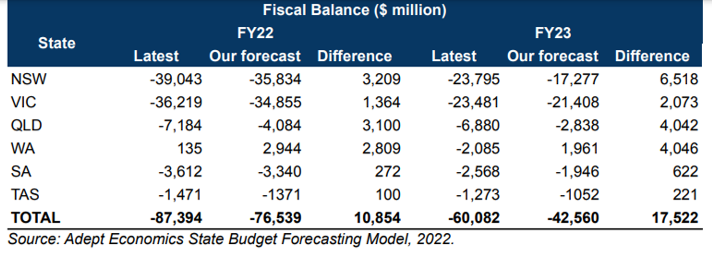State budget deficits forecast to be up to $30bn smaller over FY22 and FY23, slashing debt issuance needs
A leading economics consultancy that advises State governments, Adept Economics, has published a detailed new report that marks-to-market all the State budget deficits for this financial year (ie, FY22) while also forecasting how the deficits will change next financial year (FY23).
Authored by Gene Tunny, a former Australian Treasury official with expertise in budget analysis and policy, Adept projects that the deficits across the key States will be up to $11 billion smaller in FY22 and up to $18 billion skinnier in FY23. This results in Adept concluding that the States will reduce their debt issuance in FY23 very materially from current market consensus estimates around $80-$90 billion down to somewhere between $61-$66 billion.

This research addresses a key forecasting question that Coolabah has been focused on, which is the magnitude of the potential upside surprises in the performance of the State budgets. We have, for example, highlighted that the NSW budget deficit this financial year may end up being $5billion to $9 billion smaller than NSW projected as recently as December 2021 (Adept's numbers are more conservative than our estimates). Indeed, the NSW budget was almost in surplus in both January and February. We've also presented research on decades of data associated with State infrastructure spending that suggests infrastructure delays alone could very materially reduce State debt issuance in FY23. Precisely these types of delays have now been repeatedly flagged by the NSW government.
In the new Adept Economics expert's report, which you can download here, the primary author, Gene Tunny, comments:
Australian state budget fiscal balances are forecast to improve collectively by $9-11 billion in 2021-22 (FY22) and $13-18 billion in 2022-23 (FY23), compared with estimates in mid-financial year budget updates released at the end of the 2021 calendar year. The potential improvement in state budget balances for the non financial public sector, which includes government-owned corporations, is up to $30 billion over FY22 and FY23. This also means that state debt issuance requirements are likely to be materially downgraded, which both taxpayers and credit rating agencies will welcome at a time when interest rates on government debt are soaring...
Adept Economics projects that as a result of much smaller than expected deficits in FY22 and FY23, the states may collectively reduce debt issuance in FY23 from the current expectation of around $84 billion to somewhere between $66 billion and $61 billion.
Adept finds that the improvement in state budget balances is driven by faster-growing economy-boosting state tax revenues, elevated commodity prices enhancing royalties, and delays in infrastructure projects and related spending. Similar dynamics are obviously playing out at the Federal government level, although the Feds have huge unaccounted defence spending to pay for, as well as what is likely to be a very expensive election.
In their conservative central case, Adept assumes a decent housing downturn with house prices falling nationally by 5% over the year to 30 June 2023. They note that while NSW and Queensland have to spend several billion dollars in flood clean-up costs, the budgetary impact is largely offset by the Commonwealth paying up to 75% of the cost under the Disaster Recovery Funding Arrangements.
The table below summarises one of its key forecast scenarios for FY22 and FY23, highlighting the difference between the (dated) official State government deficit estimates and Adept's updated projections based on more recent data.

Interestingly, Adept believes that State government treasuries have been unduly pessimistic in their budget deficit forecasts, which has led to it consistently overestimating debt issuance needs that have needlessly increased the interest rates States have to pay relative to the Commonwealth government's cost of capital (or yield curve). Adept argues that a greater focus on realism in State treasury forecasts could contribute to reducing the interest rates taxpayers pay on their State government debts. This is becoming an increasingly important political issue as interest rates climb. Adept comment:
While from a budget management perspective it may be good for state governments to be prudent in their forecasts, in recent years they have been arguably too pessimistic. This reflects a more general forecasting challenge amongst economic agencies, including the Commonwealth Treasury and the Reserve Bank of Australia. A review of economic forecasting at national and economic agencies would be desirable.
Excessive pessimism in economic forecasts has real consequences for the states’ cost of capital and taxpayers. The interest rate spread the states pay on their debt above the Commonwealth yield curve has consistently jumped following excessively negative budget forecasts in 2020-21 and 2021-22, which have thereafter been massively revised down.
Following the mid-year budget updates from NSW and Victoria in December 2020, Standard & Poor’s downgraded both states from their prized AAA ratings to AA+ and AA, respectively. The loss of these AAA ratings increased both states’ cost of capital. Yet both budget updates proved to be far too pessimistic in their deficit forecasts, with the final deficits in FY21 being substantially less than the mid-year projections.
Some time ago we approached Adept as a respected economics expert with fiscal policy experience to produce their own independent State budget projections for FY22 and FY23 as a sanity test, or independent interrogation, of our own research.
We have adopted this methodology of engaging recognised external experts to evaluate the integrity of our analysis consistently over time and find that it helps to reduce the risk of internal group-think while opening our eyes to alternative perspectives.
Access Coolabah's intellectual edge
With the biggest team in investment-grade Australian fixed-income and over $7 billion in FUM, Coolabah Capital Investments publishes unique insights and research on markets and macroeconomics from around the world overlaid leveraging its 14 analysts and 5 portfolio managers. Click the ‘CONTACT’ button below to get in touch.
4 topics

